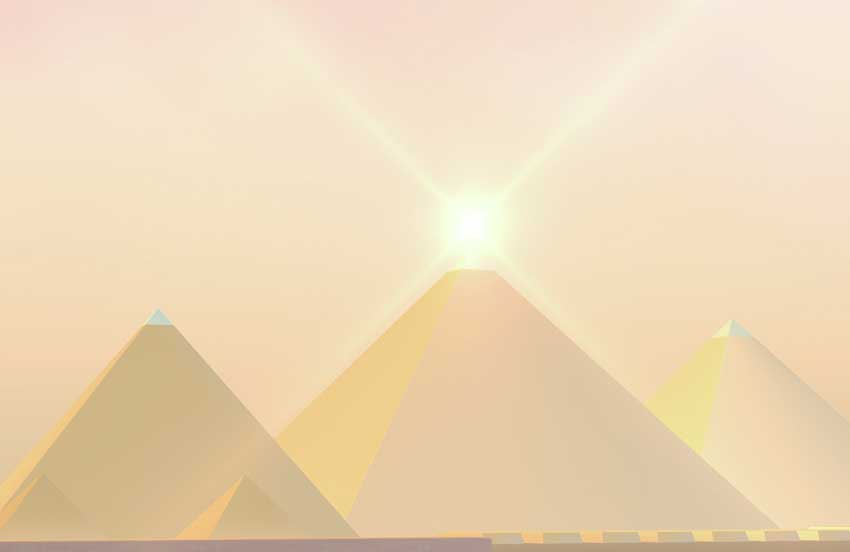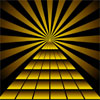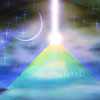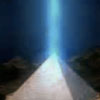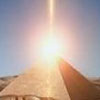Power Switch Of The Great Pyramid: The Benben
The Benben As An Anti-Gravity Device
Early Egyptian priests believed that RA and Khepra personally arrived on Earth in a mysterious ‘secret object’ called ‘Akka’. That object was later renamed ‘Benben’, a term deriving from an Egyptian word meaning ‘seed’ or ‘essence’. It is repeatedly recorded in traditional Egyptian history that the Benben ‘came from the sky’ and it became the most esteemed object of the time. The Great Ennead of Heliopolis constructed a square hewn stone column in the centre of a protective temple complex and placed the Benben upon its summit. The principal structure in that compound was called ‘The Palace of the Ancient One’ or sometimes, ‘The Palace of the Old Man’, the dwelling place of RA while he lived on Earth as King of the gods of Egypt.
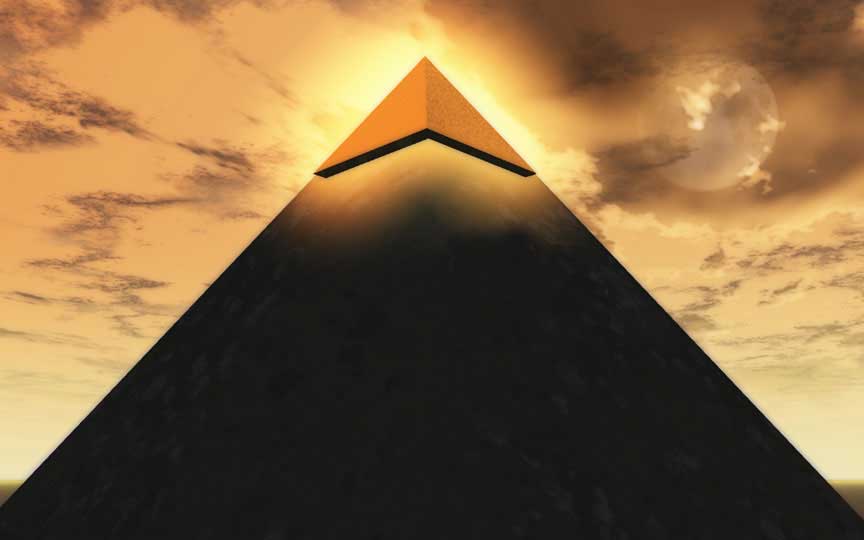 The name Benben was subsequently applied to the pyramidion or apex-stone (cap-stone) on top of pyramids, tombs and obelisks and in a symbolic sense was always associated closely and directly with both RA and Khepra. The ancient priests became famous for their privileged access into the sanctuary of that powerful, mysterious and sacred object and its specially built temple became the site where the earliest religious concepts of humans on Earth crystallized in pre-historic time. Later Egyptian priests held the strong belief that their primary gods personally arrived on Earth in the Benben and, for many centuries, revered the intriguing object as the life creation force.
The name Benben was subsequently applied to the pyramidion or apex-stone (cap-stone) on top of pyramids, tombs and obelisks and in a symbolic sense was always associated closely and directly with both RA and Khepra. The ancient priests became famous for their privileged access into the sanctuary of that powerful, mysterious and sacred object and its specially built temple became the site where the earliest religious concepts of humans on Earth crystallized in pre-historic time. Later Egyptian priests held the strong belief that their primary gods personally arrived on Earth in the Benben and, for many centuries, revered the intriguing object as the life creation force.
By and large, modern pyramidologists forced to choose between regarding the records of a supernatural construction of the Great Pyramid as fact or fiction, have chosen to treat them as fiction. However, mankind is left with some extraordinary ancient records providing fascinating narratives relating to unusual procedures in place in the development of structures in Egypt. An intriguing tradition handed down by pre-Christian Egyptian priests stated that the Great Pyramid was built from the top down. They told Herodotus: The upper portion of the Pyramid was built first, then the middle, and finally the part which was lowest and nearest the ground.
Such a construction process conjured up mental images of peculiar antigravity devices lifting and moving stones and operated by people of an unknown nature. While discussing rock and antigravity, an ancient Arabic papyrus recorded one method of moving weighty stones; ‘they put sheets of papyrus on which were written secret things beneath the stones and struck them with a rod. Whereupon the stones moved through the air by distance of one bowshot. In this way, they eventually reached the Pyramids’.
One of the most intriguing accounts of building the Great Pyramid was that given by Herodotus. He said; ‘I perfectly well remember that the interpreter who read the writing to me (the hieroglyphic descriptions) said that ‘they had a machine’. Recorded some 2400 years ago was mention of ‘a machine’ that related to a much early period and the Old Testament book of Joshua spoke of a ‘machine’ that stopped working.
Herodotus also mentioned ‘engines resting on the stones’. Diodorus Siculus recorded a similar description of raising stones ‘with engines on top…and stones sitting on…imaginary heaps of earth’. Academics supposed that engines had not yet been invented, and referred to those references as ‘being to absurd to take any notice of ’. But it ‘was a time when the Gods ruled on Earth; later they handed over the kingship to earthly rulers’.
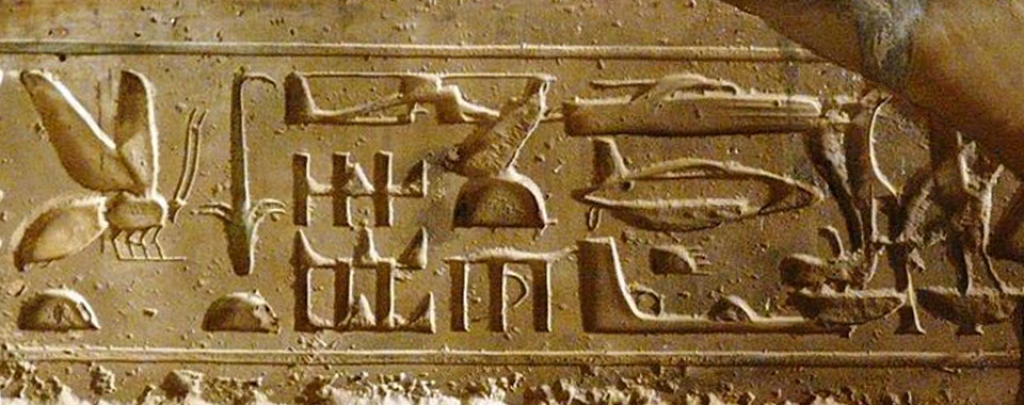 An ancient Egyptian hieroglyph translated by Wallis Budge at the British Museum in London spoke of a ‘vessel’ among the presents given to the Queen of Sheba ‘where-in one could travel by air’.
An ancient Egyptian hieroglyph translated by Wallis Budge at the British Museum in London spoke of a ‘vessel’ among the presents given to the Queen of Sheba ‘where-in one could travel by air’.
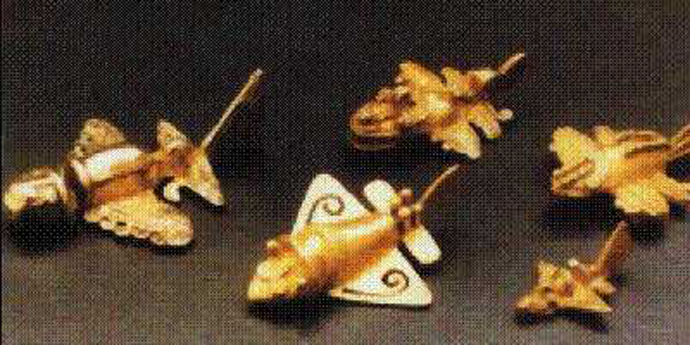 On September 25 1952, G. R. Josyner, director of the International Academy of Sanskrit Research in Mysore, India, shocked the world when he revealed that Indian manuscripts several thousand years old recorded the existence of various types of aerial vessels called ‘vimanas’. Six thousand lines of lucid Sanskrit recorded intricate details of the choice and preparation of metals suitable to build different types of aircraft for both civil aviation and warfare. Eight chapters in the ‘aeronautics’ manuscript provided detailed descriptions of craft that flew in the air, traveled underwater or floated pontoon-like on the water’s surface. Some 500 stanzas told of qualifications and training of pilots and detailed on-board equipment such as cameras, radios and a type of radar. The scrolls were preserved in monasteries centuries before the Wright Brothers made the world’s first 1000 ft (305m) powered flight at Kitty Hawk in 1903. Coronation Press of Mysore published the manuscripts in book form in English in 1973, and gave the public a certified record of flying machines on Earth thousands of years ago.
On September 25 1952, G. R. Josyner, director of the International Academy of Sanskrit Research in Mysore, India, shocked the world when he revealed that Indian manuscripts several thousand years old recorded the existence of various types of aerial vessels called ‘vimanas’. Six thousand lines of lucid Sanskrit recorded intricate details of the choice and preparation of metals suitable to build different types of aircraft for both civil aviation and warfare. Eight chapters in the ‘aeronautics’ manuscript provided detailed descriptions of craft that flew in the air, traveled underwater or floated pontoon-like on the water’s surface. Some 500 stanzas told of qualifications and training of pilots and detailed on-board equipment such as cameras, radios and a type of radar. The scrolls were preserved in monasteries centuries before the Wright Brothers made the world’s first 1000 ft (305m) powered flight at Kitty Hawk in 1903. Coronation Press of Mysore published the manuscripts in book form in English in 1973, and gave the public a certified record of flying machines on Earth thousands of years ago.
The Benben As A Power Switch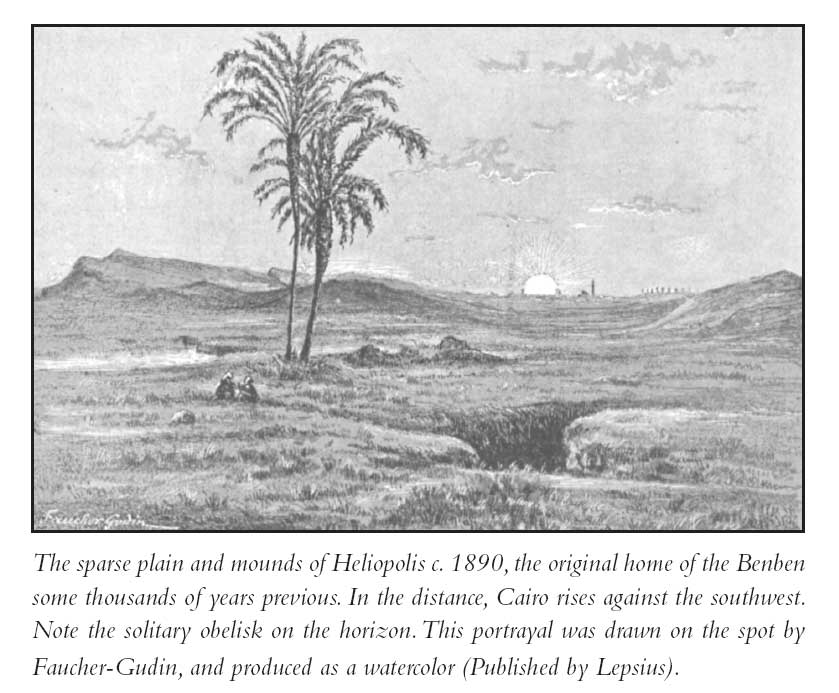
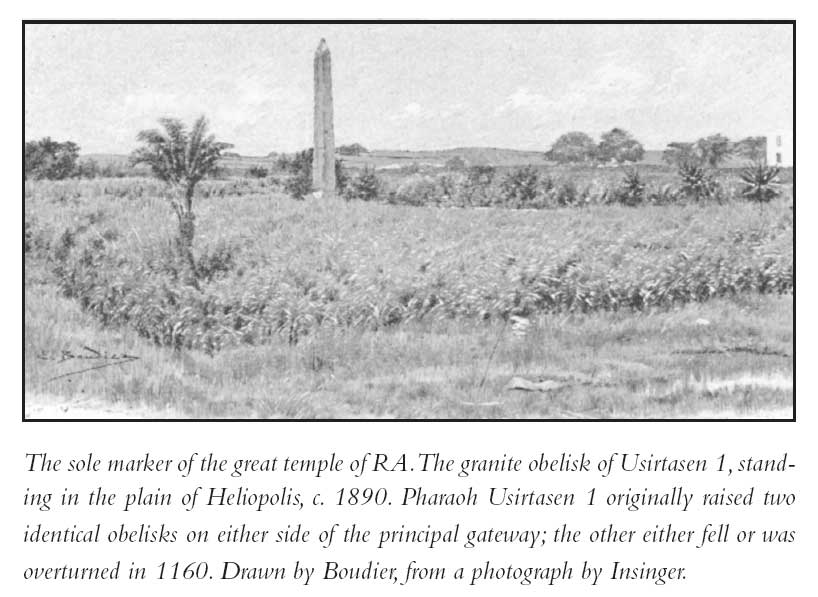
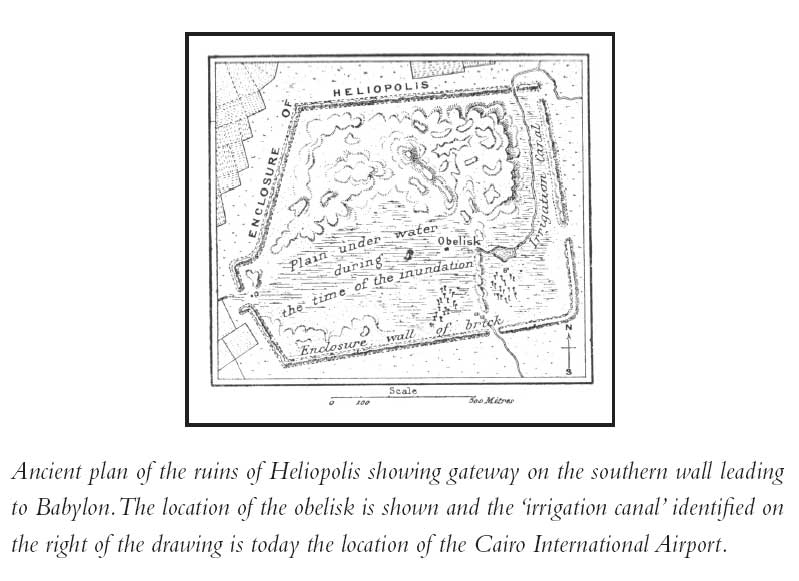 There are five excellent examples of the concept of the Benben in the main hall of the Egyptian Museum in Cairo today. The largest is the pyramidion of Amenemhet III (c. 1800 BC), a superbly crafted example in solid black granite and carved with exquisite hieroglyphs. It was found in 1902 by Professor Gaston Maspero, Director-General of the Antiquities Service, and is believed to have been intended for Amenemhet’s pyramid at Dashur, some 40 kilometres south of Giza. One of the Museum’s Benbens is of particular interest, being a slightly smaller version with a flat base on its top, reminiscent of a miniature version of the Great Pyramid itself. It provides further evidence that the very serious business of pyramid building was far more than the creation of elaborate tombs, and ancient texts reveal that many Benbens constructed during Egypt’s ’Age of Gold’
There are five excellent examples of the concept of the Benben in the main hall of the Egyptian Museum in Cairo today. The largest is the pyramidion of Amenemhet III (c. 1800 BC), a superbly crafted example in solid black granite and carved with exquisite hieroglyphs. It was found in 1902 by Professor Gaston Maspero, Director-General of the Antiquities Service, and is believed to have been intended for Amenemhet’s pyramid at Dashur, some 40 kilometres south of Giza. One of the Museum’s Benbens is of particular interest, being a slightly smaller version with a flat base on its top, reminiscent of a miniature version of the Great Pyramid itself. It provides further evidence that the very serious business of pyramid building was far more than the creation of elaborate tombs, and ancient texts reveal that many Benbens constructed during Egypt’s ’Age of Gold’
Preserved in the angles of the Benben is the origin of the true pyramid shape, and the important pyramids known today are simply larger varieties of the original Benben. Egyptologists today agree that the original surge of pyramid building was directly related to arrival of the Benben and that particular notion was further clarified in a British Museum publication, the British Museum Dictionary of Ancient Egypt. Authors Ian Shaw and Paul Nicholson extended the view that the Benben ‘served as the earliest prototype for the obelisk and possibly even the Pyramid’.
It is clear the original Benben was of immense spiritual importance, and all major pyramids in Egypt today appear to be gigantic recreations of it. The conclusion reached in this work is that the Great Pyramid was originally and specifically built to accommodate the Benben upon its platformed location at the highest point. When the object was in place, it somehow activated the Pyramid Effect, or invisible force, that subsequently ‘switched the pyramid on’. It appears the Benben served as the catalyst to energize the specially designed interior chambers of the Pyramid. When the Egyptian priests told Herodotus that the Great Pyramid was built from the top down, they meant that the Benben came first and provided the precise angles required to construct the Pyramid proper. When the main structure was completed, the smaller Benben was placed in its special position on top of the larger Benben. In other words, the top came first, apparently from some sort of supernatural or cosmic origin, and with it was the Company of Gods who subsequently instructed the locals in its purpose.
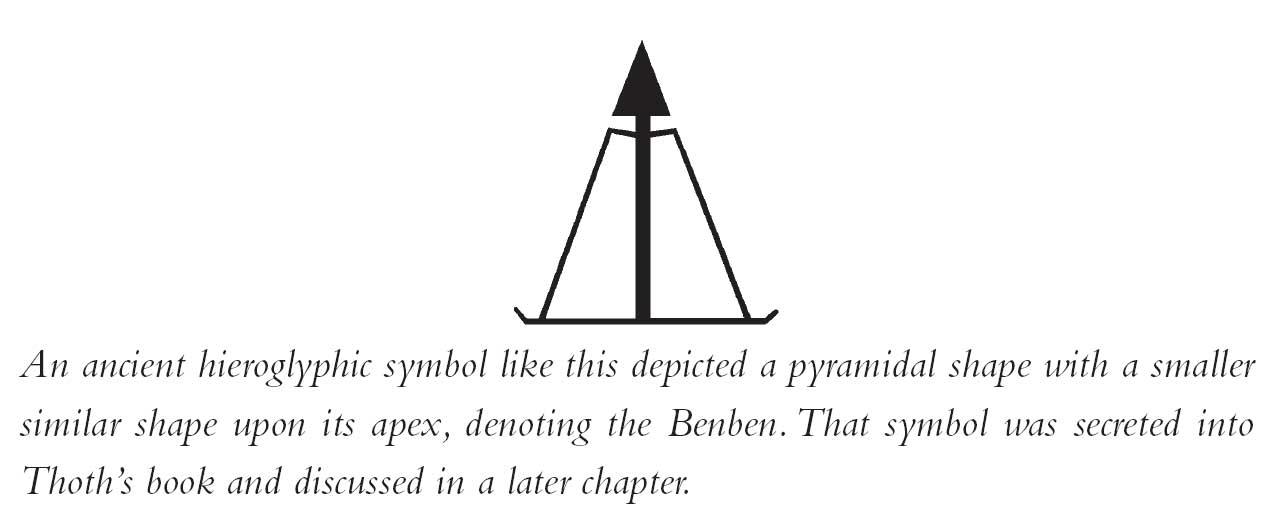
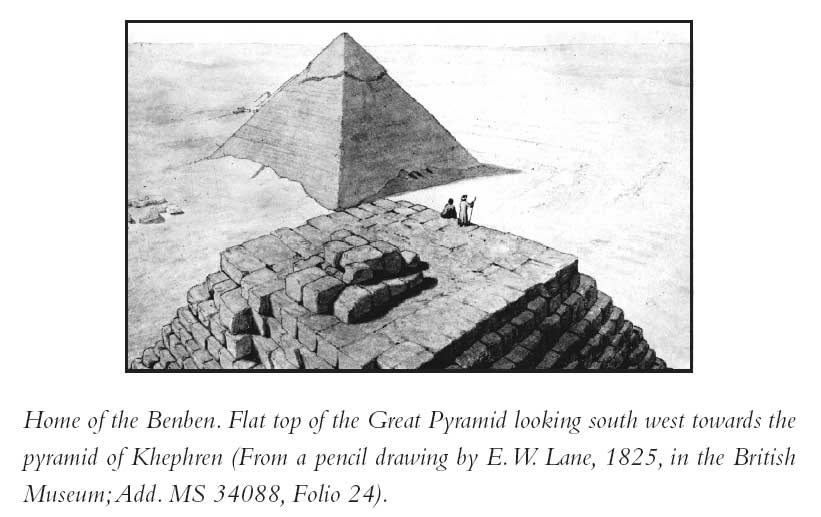 A true pyramid is actually a Benben on top of a Benben and that was the ancient name given to their crowning pyramidions. The Great Pyramid is certainly a true pyramid and temple records confirm that it was void of its Benben for at least 4000 years. Roman historian, Diodorus Siculus, visited the Great Pyramid shortly before the beginning of the First Century and wrote that the top of the structure ‘appeared flat like a platform’. At the time of Senuseret (c. 1971 BC), stone records state that the Benben was sitting upon a large square stone pillar in its Temple at Heliopolis, a few kilometres away. There it became the first obelisk in mankind’s recorded history and was the original concept of a square-base, pointed structure reaching high into the sky on a four-sided column. If the dating of the Pharaohs’ lifetime is as Egyptologists calculated, then it is possible to determine that something unusual happened to the Benben just thirty years after the time of Senuseret. Pharaoh Sesostris I (c. 1940 BC), who restored the sacred city of Heliopolis, said the Benben was ‘removed’ and he personally ordered an inscription to be carved on a remembrance stele that said, ‘My Beauty, Benben, shall be remembered in his House; (The Temple of the Benben) my name is the Benben’.
A true pyramid is actually a Benben on top of a Benben and that was the ancient name given to their crowning pyramidions. The Great Pyramid is certainly a true pyramid and temple records confirm that it was void of its Benben for at least 4000 years. Roman historian, Diodorus Siculus, visited the Great Pyramid shortly before the beginning of the First Century and wrote that the top of the structure ‘appeared flat like a platform’. At the time of Senuseret (c. 1971 BC), stone records state that the Benben was sitting upon a large square stone pillar in its Temple at Heliopolis, a few kilometres away. There it became the first obelisk in mankind’s recorded history and was the original concept of a square-base, pointed structure reaching high into the sky on a four-sided column. If the dating of the Pharaohs’ lifetime is as Egyptologists calculated, then it is possible to determine that something unusual happened to the Benben just thirty years after the time of Senuseret. Pharaoh Sesostris I (c. 1940 BC), who restored the sacred city of Heliopolis, said the Benben was ‘removed’ and he personally ordered an inscription to be carved on a remembrance stele that said, ‘My Beauty, Benben, shall be remembered in his House; (The Temple of the Benben) my name is the Benben’.
Strange Forces Operating In The Great Pyramid
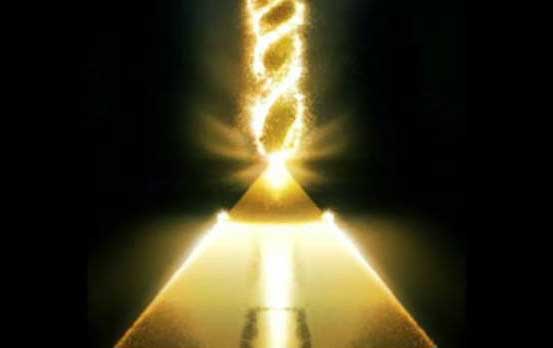 There is a strange force at work in the Great Pyramid. That force defies present scientific explanation and no one is able to adequately explain how it works. Special energy tests done with dowsing rods at the original location of the Benben detected a definite invisible force streaming down from the highest point of the Great Pyramid that pulled the tip of dowsing rods sharply down. One of the earliest researchers in that area was Verne Cameron, a well-known English dowser who developed a dowsing device called an ‘aurameter’. In a series of tests under variant conditions, he was another that detected a positive downward flow of energy at the top of the pyramid, accompanied by a simultaneous upward flow. Others detected a similar force and described it as the feeling of a cool breeze flowing vertically against the fingers and palms when they held their hands above their heads. Once, while standing in the centre on top of the Great Pyramid with a companion and some Arab guides, British inventor, Sir W. Siemens, noted that whenever his hand was raised with fingers outspread he could hear an acute ringing noise. Curious, he converted a bottle into a Leydon jar (one that accumulates static electricity), held it over his head, and sparks began to fly from the neck of the bottle. The guides became fearful and threatened him, and Siemens accidentally lowered the bottle towards one of them, giving the guide an electric shock that knocked him from his feet.
There is a strange force at work in the Great Pyramid. That force defies present scientific explanation and no one is able to adequately explain how it works. Special energy tests done with dowsing rods at the original location of the Benben detected a definite invisible force streaming down from the highest point of the Great Pyramid that pulled the tip of dowsing rods sharply down. One of the earliest researchers in that area was Verne Cameron, a well-known English dowser who developed a dowsing device called an ‘aurameter’. In a series of tests under variant conditions, he was another that detected a positive downward flow of energy at the top of the pyramid, accompanied by a simultaneous upward flow. Others detected a similar force and described it as the feeling of a cool breeze flowing vertically against the fingers and palms when they held their hands above their heads. Once, while standing in the centre on top of the Great Pyramid with a companion and some Arab guides, British inventor, Sir W. Siemens, noted that whenever his hand was raised with fingers outspread he could hear an acute ringing noise. Curious, he converted a bottle into a Leydon jar (one that accumulates static electricity), held it over his head, and sparks began to fly from the neck of the bottle. The guides became fearful and threatened him, and Siemens accidentally lowered the bottle towards one of them, giving the guide an electric shock that knocked him from his feet.
Planes and particularly helicopters are warned not to fly low over tops of pyramids because of the force operating above the centre of the apex. Pilots reported that instruments go awry while flying over pyramidal structures and in one case, in 1968, at the Great Pyramid, a helicopter with crew photographing the platform at close range, was violently and unexplainably de-stabilized, causing a crash landing near the base of the Great Pyramid.
Inside The Benben
It can be confidently said that something of a non-ordinary nature is constantly happening within a Benben-type pyramidal space, and that claim is supportable with physical evidence. When a light is shone down into the apex of a glass or crystal pyramid of any size, but built to the same angles and ratio as the Great Pyramid, something remarkable occurs. Rising out of the area that would be the location of the Queen’s Chamber and moving up through the King’s Chamber area, a spectacular spiral or swirl of light resembling a serpent standing upright upon its tail is seen. That beautifully proportioned form is created in the seven rainbow colours, and its highest-most point disappears out of the top centre of the pyramid in an ever-decreasing spiral. Some have known for thousands of years of the existence of that marvelous occurrence and it holds untold ramifications for the spiritual development of mankind.
Because of its form and colour, the phenomenon is known as ‘The Rainbow Serpent’ because that is exactly what it looks like when viewed through any or all, four sides of a miniature clear model of the Great Pyramid. In its original form, it was visible in the larger Benben, and ancient Egyptian priests called the vertical spiral of light, Khepra. To them it was God.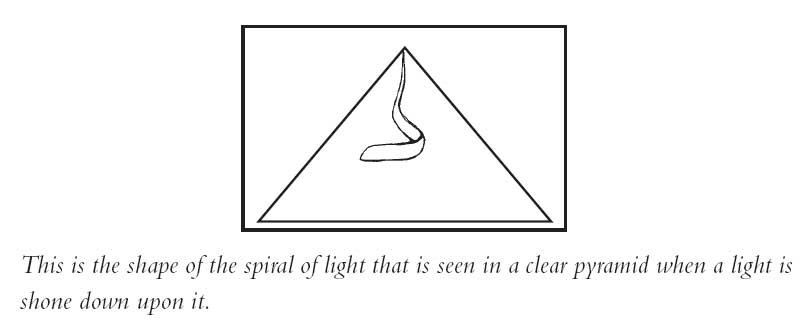 It is demonstrated with a transparent model of the Great Pyramid that there is a direct relationship between the shape of the space inside, and a particular process going on within that space. Whenever a light is shone down into a glass pyramid built in exact scale or proportion to the Great Pyramid, a Rainbow Serpent is created. The light provides a type of force or energy that in turn, creates the vertical spiral of light, a serpent upraised, invisible in rock, but visible in a clear substance. That is what the ancient Egyptian priesthood meant when they said that, ‘a serpent lies coiled in the Great Pyramid’.
It is demonstrated with a transparent model of the Great Pyramid that there is a direct relationship between the shape of the space inside, and a particular process going on within that space. Whenever a light is shone down into a glass pyramid built in exact scale or proportion to the Great Pyramid, a Rainbow Serpent is created. The light provides a type of force or energy that in turn, creates the vertical spiral of light, a serpent upraised, invisible in rock, but visible in a clear substance. That is what the ancient Egyptian priesthood meant when they said that, ‘a serpent lies coiled in the Great Pyramid’.
Priesthood knowledge appears to directly reference the known existence of an invisible spiral force operating within the confines of the Great Pyramid, precisely in the same manner as the spiral of visible light was seen in the Benben. That explains exactly what the Benben originally was, but much larger; it was a clear pyramidal structure acting as a focal point to gather in, convert and distribute light from the sun into energy, and project its force deep into the heart of the Pyramid. The conclusion reached in this premise determines that the cosmic Benben was a God-given perpetual generator, placed in a location where the sun shone 315 days every year.
Thus, the Benben served not only as a receiver of light but also as a self-feeding projector. The pyramid form itself sustained the constant charge of sunlight generated in the Benben gracing the peak of the Great White Rock. It appears that the Benben was primarily intended as a type of amplifying principle to activate power into the specially designed chambers and passageways in the structure below. With the Sun shining down upon it, a huge Rainbow Serpent was created and could be seen from miles away. Since the pyramid form was the only method to generate (or create) the Rainbow Serpent, the serpent became the symbolic form of initiates. The Book of the Dead said initiates into the Egyptian Mysteries entered ‘a serpent’, in which they ‘shed their skin’ and emerged ‘in the form of a resurrected Ra, bright and shiny’. That was the fundamental nature of the initiatory process.
With the penetration of the sun’s rays down into the Benben, the upraised serpent in the component colours of the spectrum was visible from all sides of the Great Pyramid and its crystalline cap glowed with the vertical spiral of light. The Bible said God’s presence was seen on top of the mountain, that being the ‘mountain of stone’ now called the Great Pyramid. God’s presence was Khepra, the Rainbow Serpent spiraling in the Luminous Crown.
With the Benben in place, the Great Pyramid became a living ark of mysterious force. A fiery halo was often seen to glow around the apex and strange deep rumbling sounds arose around the structure. That was one reason why the Great Pyramid was held with fear. With the sun shining down upon it, ‘a serpent was seen lighted on top of the House of God’, and that Serpent could clearly be seen standing, as it were, upright in the middle of the Benben. That was what numerous ancient records documented, and Moses’ ‘bronze serpent’ was a physical reconstruction of it.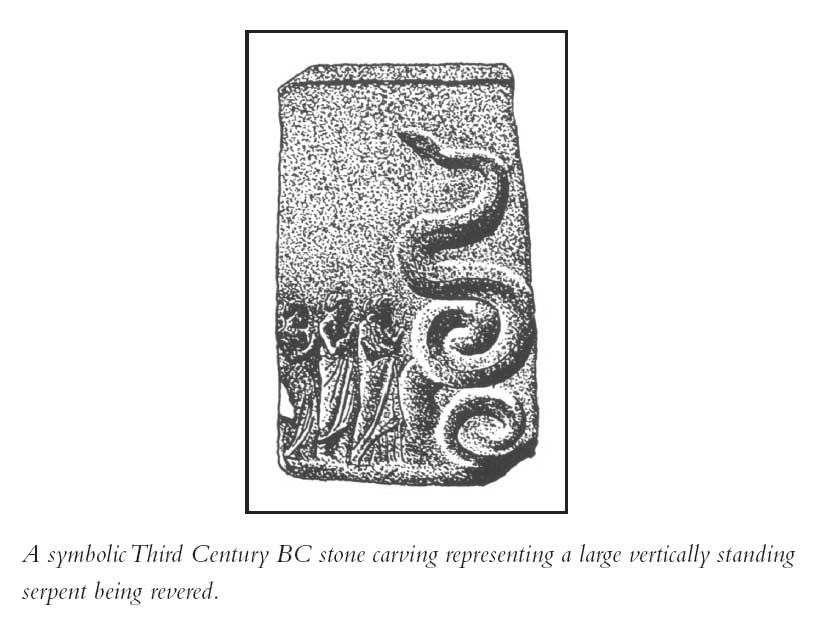 The Book of the Dead provides a clear description of the Rainbow Serpent and its specially constructed location. Stone lasts forever and inscribed in it are these remarkable words: ’Hail, shining one, above the Temple of the Gods in visible form…swirling above the white Temple in the sand’. Moreover, what was being described in the Book of Enoch in this extraordinary collection of words?
The Book of the Dead provides a clear description of the Rainbow Serpent and its specially constructed location. Stone lasts forever and inscribed in it are these remarkable words: ’Hail, shining one, above the Temple of the Gods in visible form…swirling above the white Temple in the sand’. Moreover, what was being described in the Book of Enoch in this extraordinary collection of words?
…and he drew nigh to a large structure which was built of crystal…and containing tongues of flame…and the aslant walls of the structure were covered with a tessellated flow of crystal…and its base was of crystal.
Later in the Book of Enoch, that ‘structure’ is referred to as ‘the holy radiating jewel’, an exquisite description that supports Tibetan tradition of the Benben being ‘surrounded by a radiance, and flowing with rivers of light’.
Earlier chapters mentioned the ‘old book’ found by Hilkiah around 400 BC. Written on a peculiar fabric, that mysterious document was called the Book of God and carried within it coloured illustrations or depictions and precisely described the Rainbow Serpent. Look again, at what was said:
…the Divine Essence…like a luminous serpent proceeding up to form a circle, and then having attained the highest point of its circumference, the ineffable Glory bends back down again.
That ancient description suggested the Rainbow Serpent was created from a force acting directly down and then shadowing up again (a twisted double helix format; like a DNA strand), creating an intertwined radiant spiral of vertical light with a mirror-type reflection (a twin, so to speak).
Excerpt from The Secret In The Bible
Posted in Other Topics, True History of Manwith comments disabled.

